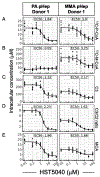A novel small molecule approach for the treatment of propionic and methylmalonic acidemias
- PMID: 33741272
- PMCID: PMC9109253
- DOI: 10.1016/j.ymgme.2021.03.001
A novel small molecule approach for the treatment of propionic and methylmalonic acidemias
Abstract
Propionic Acidemia (PA) and Methylmalonic Acidemia (MMA) are inborn errors of metabolism affecting the catabolism of valine, isoleucine, methionine, threonine and odd-chain fatty acids. These are multi-organ disorders caused by the enzymatic deficiency of propionyl-CoA carboxylase (PCC) or methylmalonyl-CoA mutase (MUT), resulting in the accumulation of propionyl-coenzyme A (P-CoA) and methylmalonyl-CoA (M-CoA in MMA only). Primary metabolites of these CoA esters include 2-methylcitric acid (MCA), propionyl-carnitine (C3), and 3-hydroxypropionic acid, which are detectable in both PA and MMA, and methylmalonic acid, which is detectable in MMA patients only (Chapman et al., 2012). We deployed liver cell-based models that utilized PA and MMA patient-derived primary hepatocytes to validate a small molecule therapy for PA and MMA patients. The small molecule, HST5040, resulted in a dose-dependent reduction in the levels of P-CoA, M-CoA (in MMA) and the disease-relevant biomarkers C3, MCA, and methylmalonic acid (in MMA). A putative working model of how HST5040 reduces the P-CoA and its derived metabolites involves the conversion of HST5040 to HST5040-CoA driving the redistribution of free and conjugated CoA pools, resulting in the differential reduction of the aberrantly high P-CoA and M-CoA. The reduction of P-CoA and M-CoA, either by slowing production (due to increased demands on the free CoA (CoASH) pool) or enhancing clearance (to replenish the CoASH pool), results in a net decrease in the CoA-derived metabolites (C3, MCA and MMA (MMA only)). A Phase 2 study in PA and MMA patients will be initiated in the United States.
Keywords: Methylmalonic acidemia; Propionic acidemia.
Copyright © 2021 The Authors. Published by Elsevier Inc. All rights reserved.
Conflict of interest statement
Conflict of interest The following authors have units of ownership in HemoShear Therapeutics, Inc.: Allison J Armstrong, Maria Sol Collado, Matthew W Olson, Stephen A Hoang, Christin A Hamilton, Brian A Johns, Brian R Wamhoff, John E Reardon, and Robert A Figler. Author, Kimberly A Chapman, is the PI on the HemoShear Therapeutics' sponsored HERO (Helping Reduce Organic Acids) Clinical Trial at Children's National Medical Center, Washington DC.
Figures






References
-
- Thompson GN, Chalmers RA. Increased Urinary Metabolite Excretion during Fasting in Disorders of Propionate Metabolism [Internet]. Pediatric Research 1990;27(4):413–416. - PubMed
-
- Sbai D et al. Contribution of odd-chain fatty acid oxidation to propionate production in disorders of propionate metabolism. The American journal of clinical nutrition 1994;59:1332–1337. - PubMed
-
- Zwickler T et al. Usefulness of biochemical parameters in decision-making on the start of emergency treatment in patients with propionic acidemia. Journal of Inherited Metabolic Disease 2014;37(1):31–37. - PubMed
-
- Zwickler T et al. Metabolic decompensation in methylmalonic aciduria: Which biochemical parameters are discriminative?. Journal of Inherited Metabolic Disease 2012;35(5):797–806. - PubMed
Publication types
MeSH terms
Substances
Supplementary concepts
Grants and funding
LinkOut - more resources
Full Text Sources
Other Literature Sources
Medical
Miscellaneous

